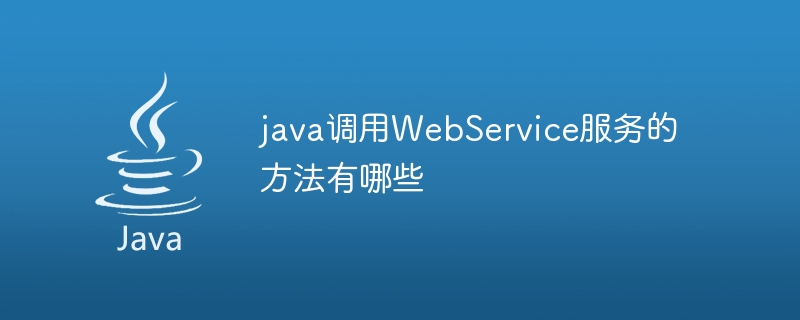
제목: WebService 서비스 호출을 위한 Java 메서드 및 코드 예제
요약: 이 문서에서는 Java에서 WebService 서비스를 호출하는 여러 메서드를 소개하고 구체적인 코드 예제를 제공합니다. axis2를 사용하여 클라이언트 코드 생성, JAX-WS를 사용하여 클라이언트 코드 생성, Apache CXF를 사용하여 클라이언트 코드 생성, Spring Boot를 사용하여 WebService 서비스 통합 등이 포함됩니다. 이러한 방법을 통해 Java를 쉽게 구현하여 WebService 서비스를 호출할 수 있습니다.
텍스트:
Axis2는 오픈 소스 WebService 프레임워크입니다. axis2를 사용하여 클라이언트 코드를 생성하면 WebService 서비스 호출 프로세스를 단순화할 수 있습니다.
먼저 Eclipse에서 Java 프로젝트를 생성하고 axis2 관련 jar 패키지를 가져옵니다.
다음으로 프로젝트 루트 디렉터리에 "axis2Client"라는 패키지를 생성하고, "Axis2Client"라는 패키지 아래에 새 클래스를 생성합니다.
다음은 axis2를 사용하여 WebService 서비스를 호출하는 샘플 코드입니다.
package axis2Client;
import org.apache.axis2.AxisFault;
import org.apache.axis2.Constants;
import org.apache.axis2.addressing.EndpointReference;
import org.apache.axis2.client.Options;
import org.apache.axis2.client.ServiceClient;
import org.apache.axis2.client.async.AsyncResult;
import org.apache.axis2.client.async.Callback;
import org.apache.axis2.client.async.CallbackHandler;
import org.apache.axis2.client.async.InvocationCallback;
import org.apache.axis2.client.async.Result;
import org.apache.axis2.transport.http.HTTPConstants;
public class Axis2Client {
public static void main(String[] args) {
try {
// 创建ServiceClient对象
ServiceClient client = new ServiceClient();
// 设置服务地址
Options options = new Options();
options.setTo(new EndpointReference("http://localhost:8080/axis2/services/MyService"));
// 设置超时时间(可选)
options.setTimeOutInMilliSeconds(60000);
// 设置请求SOAP头(可选)
options.setProperty(HTTPConstants.CHUNKED, Constants.VALUE_FALSE);
options.setProperty(HTTPConstants.REUSE_HTTP_CLIENT, Constants.VALUE_TRUE);
// 设置认证信息(可选)
options.setUserName("username");
options.setPassword("password");
// 将配置应用到ServiceClient对象
client.setOptions(options);
// 调用WebService方法
Object[] result = client.invokeBlocking(
new QName("http://service.namespace.com/", "operationName"),
new Object[] { "parameter" },
new Class[] { String.class });
// 处理返回结果
String response = (String) result[0];
System.out.println(response);
} catch (AxisFault e) {
e.printStackTrace();
}
}
}JAX-WS(Java API for XML Web Services)는 Soap-WS를 개발하기 위한 도구입니다. 기반 웹 서비스 Java 표준을 사용하면 JAX-WS를 사용하여 클라이언트 코드를 생성함으로써 WebService 서비스를 더 쉽게 호출할 수 있습니다.
먼저 Eclipse에서 Java 프로젝트를 생성하고 JAX-WS 관련 jar 패키지를 가져옵니다.
다음으로 프로젝트 루트 디렉터리에 "jaxwsClient"라는 패키지를 생성하고, "JaxwsClient"라는 패키지 아래에 새 클래스를 생성합니다.
다음은 JAX-WS를 사용하여 WebService 서비스를 호출하는 샘플 코드입니다.
package jaxwsClient;
import javax.xml.namespace.QName;
import javax.xml.ws.Service;
import java.net.URL;
public class JaxwsClient {
public static void main(String[] args) {
try {
// 创建服务的URL对象
URL url = new URL("http://localhost:8080/MyService?wsdl");
// 创建服务对象
QName qname = new QName("http://service.namespace.com/", "MyService");
Service service = Service.create(url, qname);
// 获取服务的端口对象
MyServicePortType port = service.getPort(MyServicePortType.class);
// 调用WebService方法
String response = port.operationName("parameter");
// 处理返回结果
System.out.println(response);
} catch (Exception e) {
e.printStackTrace();
}
}
}Apache CXF는 Apache CXF를 사용하여 클라이언트를 생성하여 웹 서비스를 개발하기 위한 프레임워크입니다. 코드 WebService 서비스 호출 프로세스를 단순화할 수 있습니다.
먼저 Eclipse에서 Java 프로젝트를 생성하고 Apache CXF 관련 jar 패키지를 가져옵니다.
다음으로 프로젝트 루트 디렉터리에 "cxfClient"라는 패키지를 생성하고 "CxfClient"라는 패키지 아래에 새 클래스를 생성합니다.
다음은 Apache CXF를 사용하여 WebService 서비스를 호출하는 샘플 코드입니다.
package cxfClient;
import org.apache.cxf.jaxws.JaxWsProxyFactoryBean;
public class CxfClient {
public static void main(String[] args) {
try {
// 创建JaxWsProxyFactoryBean对象
JaxWsProxyFactoryBean factory = new JaxWsProxyFactoryBean();
// 设置服务地址
factory.setAddress("http://localhost:8080/MyService");
// 设置服务接口
factory.setServiceClass(MyServicePortType.class);
// 创建接口代理对象
MyServicePortType port = (MyServicePortType) factory.create();
// 调用WebService方法
String response = port.operationName("parameter");
// 处理返回结果
System.out.println(response);
} catch (Exception e) {
e.printStackTrace();
}
}
}Spring Boot는 WebService 서비스에 대한 통합 기능을 제공하므로 WebService 서비스를 통합하는 것이 더 편리할 수 있습니다. Spring Boot를 사용하여 WebService를 호출합니다.
먼저 Spring Boot 프로젝트에서 WebService에 대한 지원을 추가하고 "MyService"라는 인터페이스를 생성한 후 WebService의 작동 방법을 정의합니다.
@WebService
public interface MyService {
@WebMethod
String operationName(String parameter);
}그런 다음 Spring Boot 프로젝트에서 "MyServiceImpl"이라는 클래스를 생성하고 "MyService" 인터페이스를 구현한 다음 인터페이스에 정의된 작업 메서드를 구현합니다.
@WebService(serviceName = "MyService")
public class MyServiceImpl implements MyService {
@Override
public String operationName(String parameter) {
// 业务逻辑处理
return "response";
}
}마지막으로 Spring Boot 프로젝트에서 관련 구성을 만들고 Spring Boot 애플리케이션을 시작한 다음 WebService를 호출합니다.
@RestController
public class MyController {
private final MyService myService;
public MyController(MyService myService) {
this.myService = myService;
}
@GetMapping("/invokeWebService")
public String invokeWebService() {
String response = myService.operationName("parameter");
return response;
}
}요약:
이 문서에서는 Java에서 WebService 서비스를 호출하는 여러 가지 방법을 소개하고 구체적인 코드 예제를 제공합니다. 이러한 메소드를 사용하면 WebService 서비스에 대한 Java 호출을 쉽게 구현할 수 있습니다.
위 내용은 Java에서 WebService 서비스를 호출하는 방법은 무엇입니까?의 상세 내용입니다. 자세한 내용은 PHP 중국어 웹사이트의 기타 관련 기사를 참조하세요!